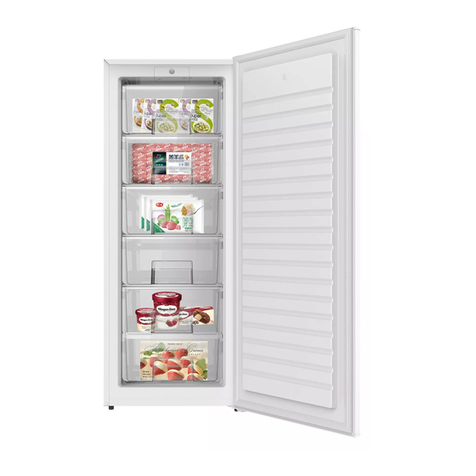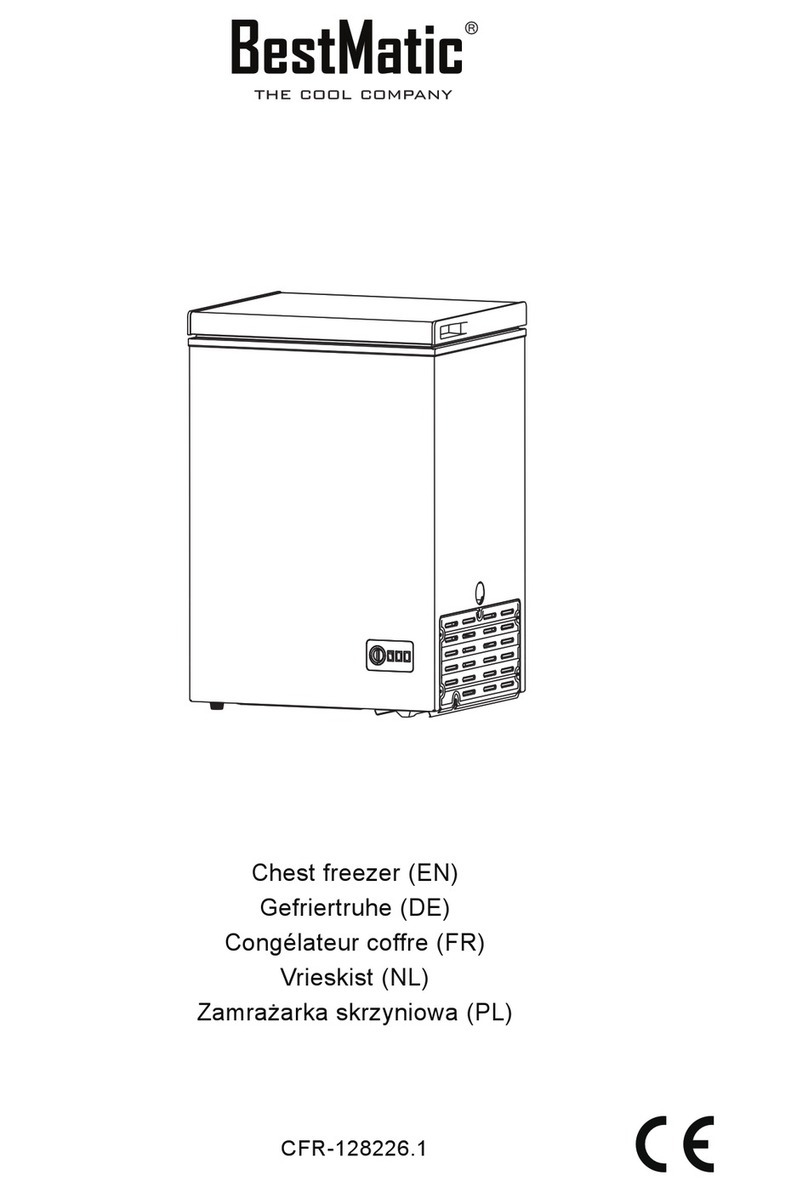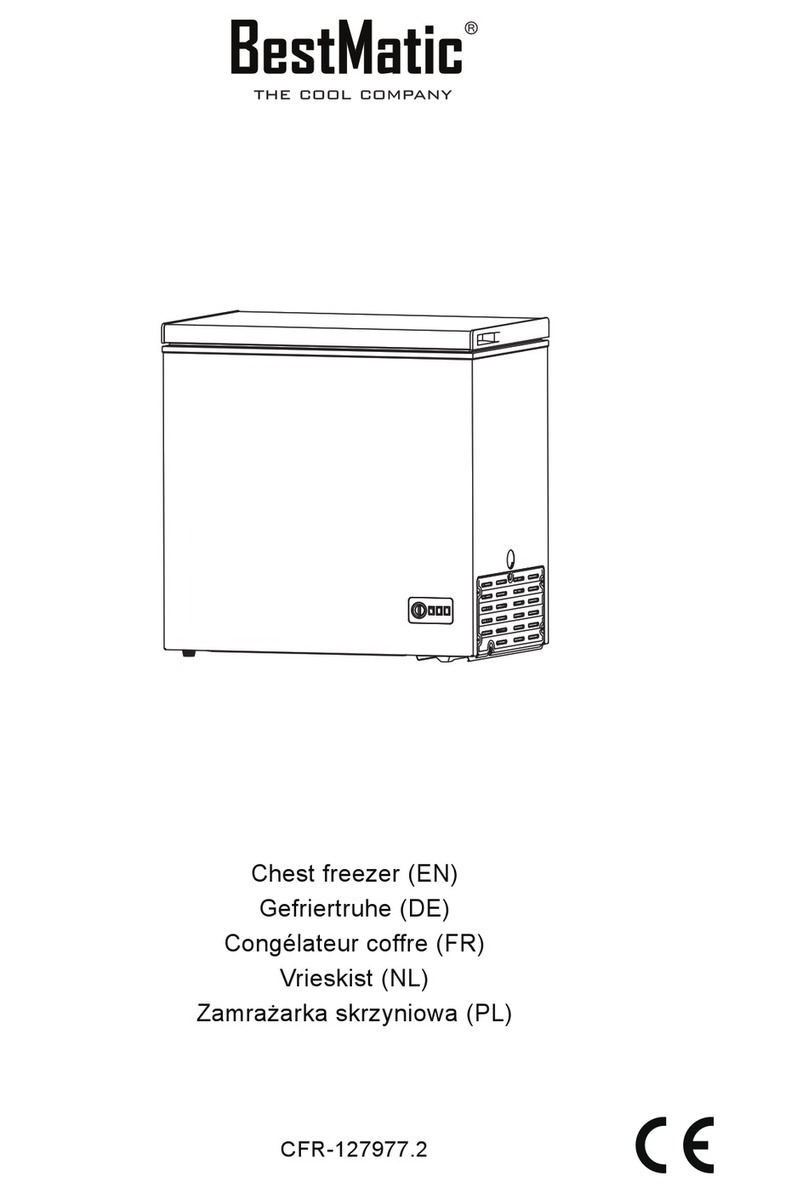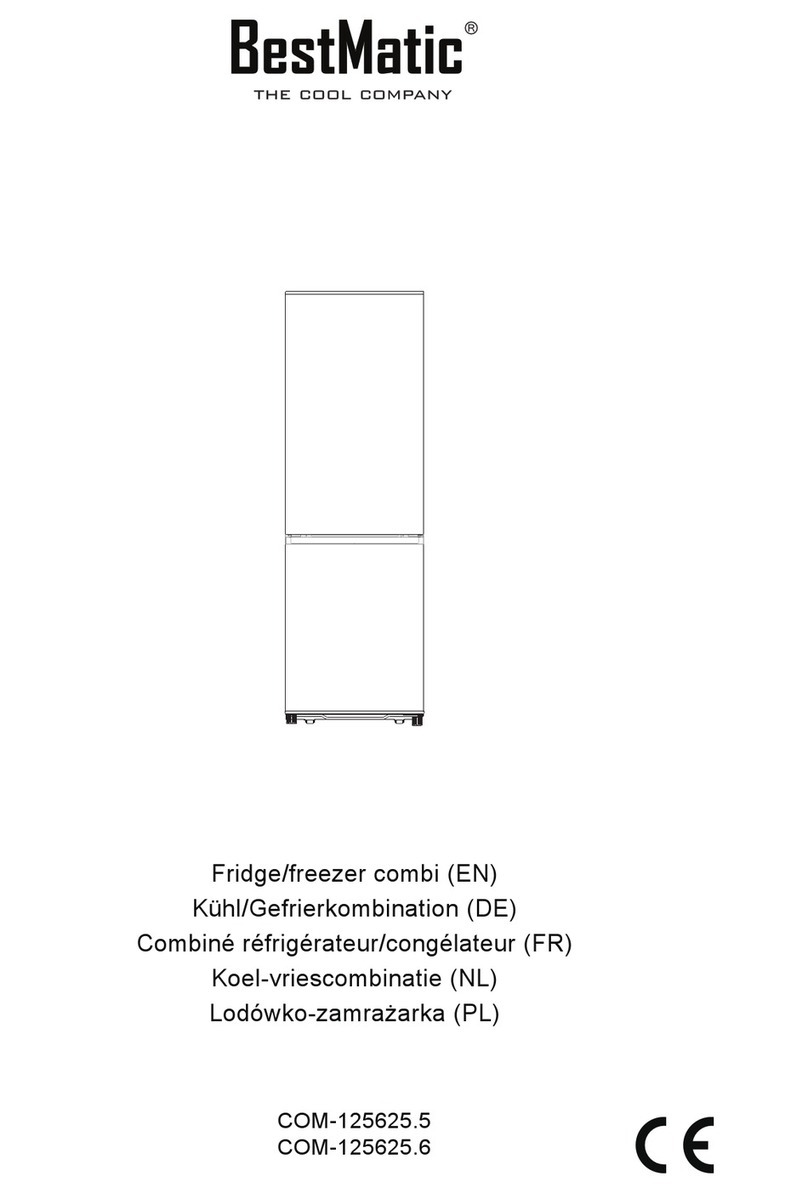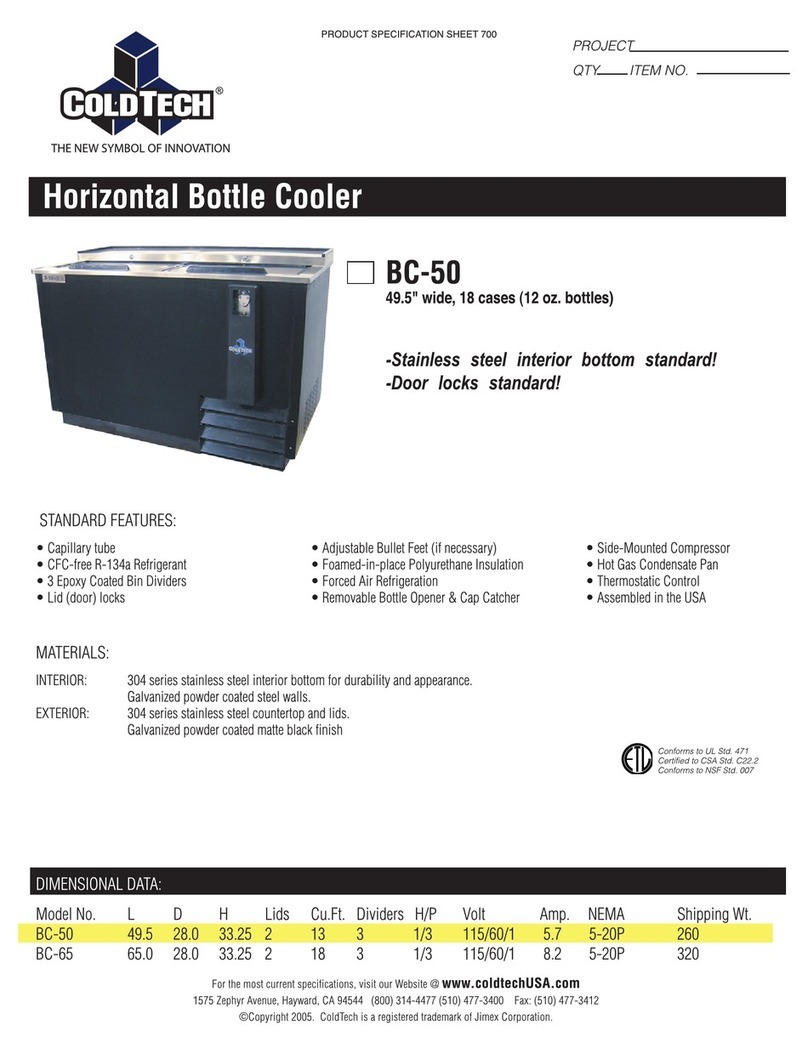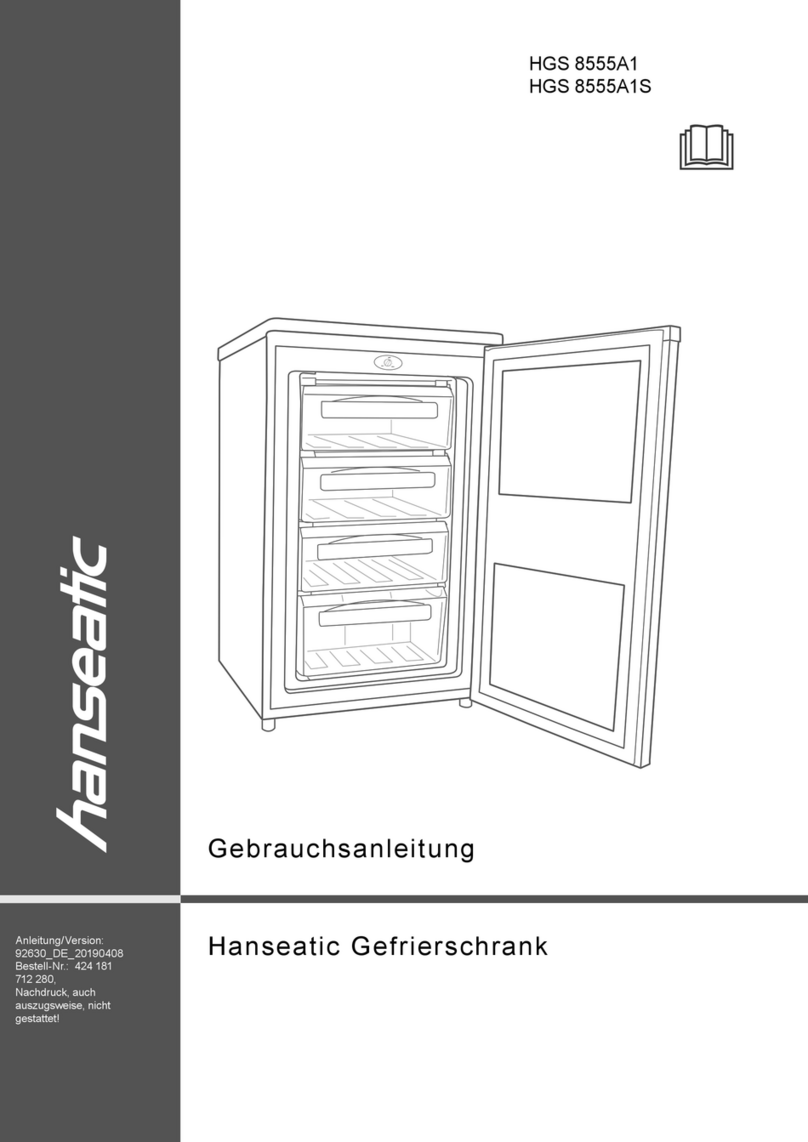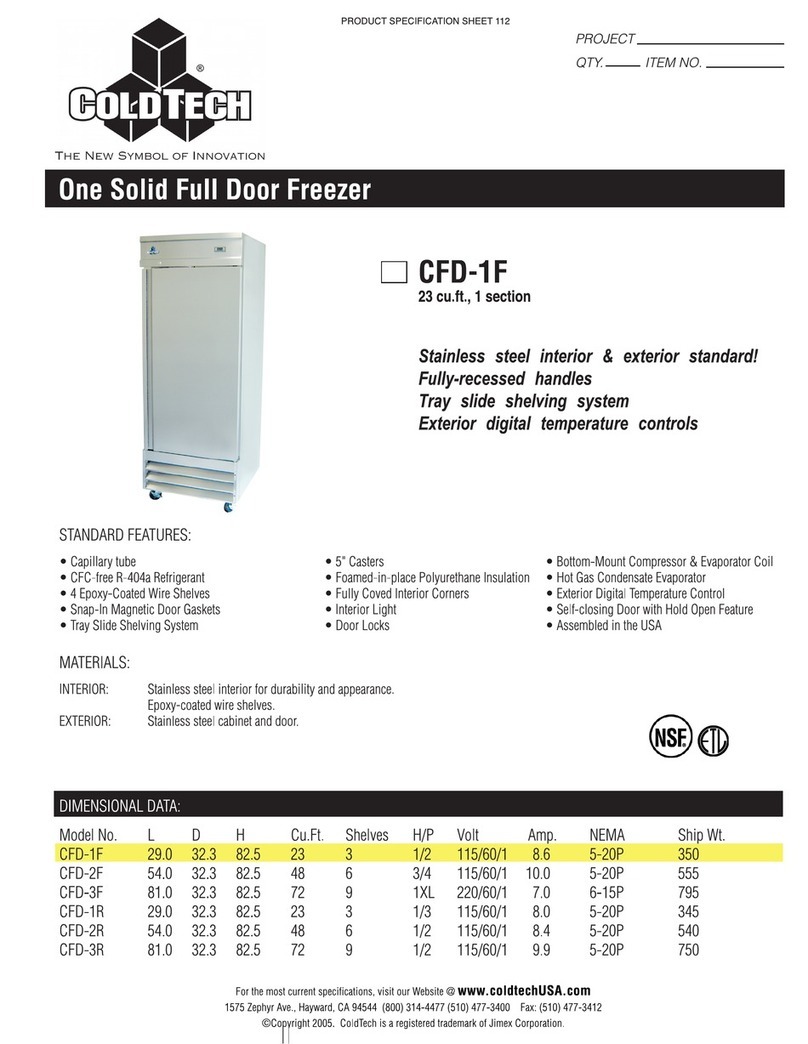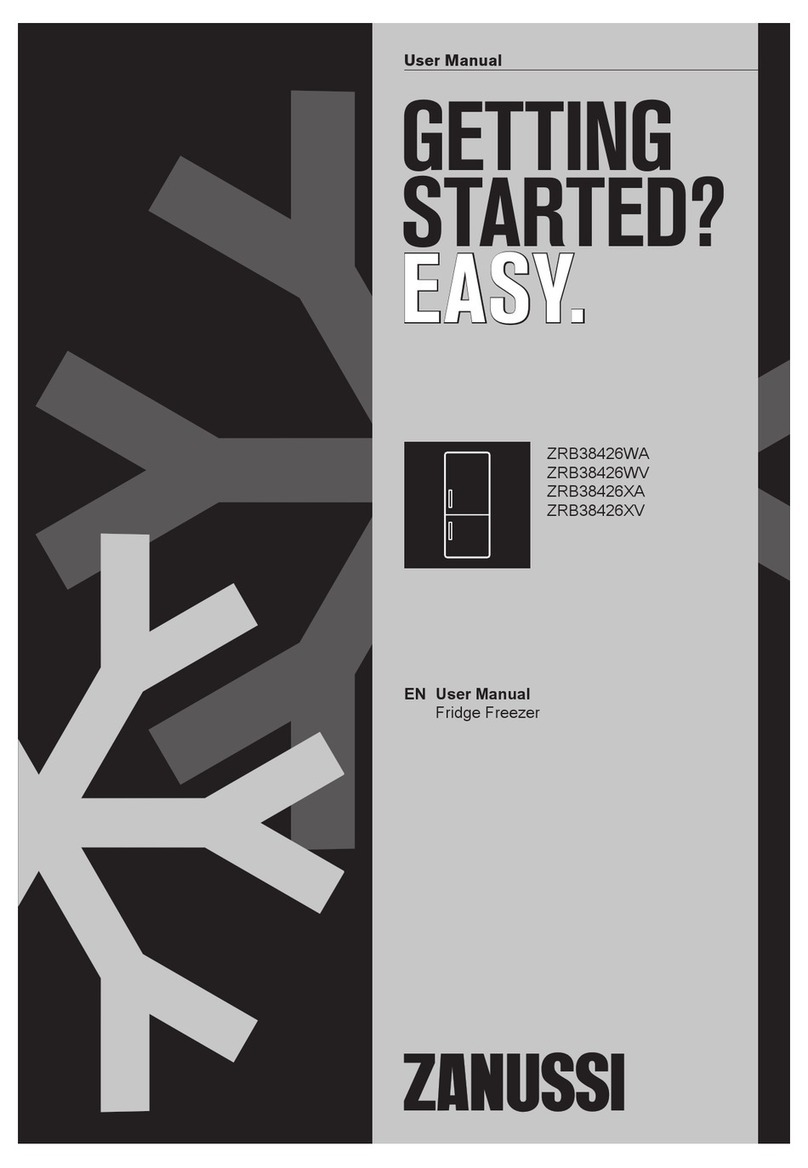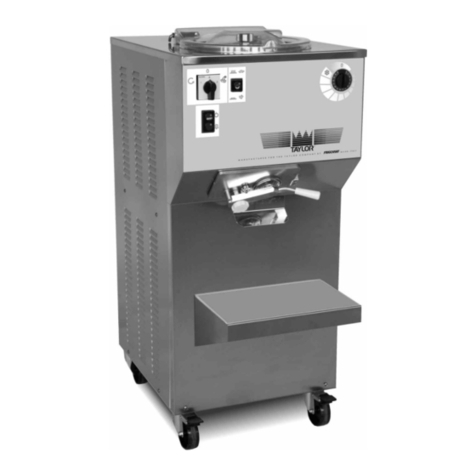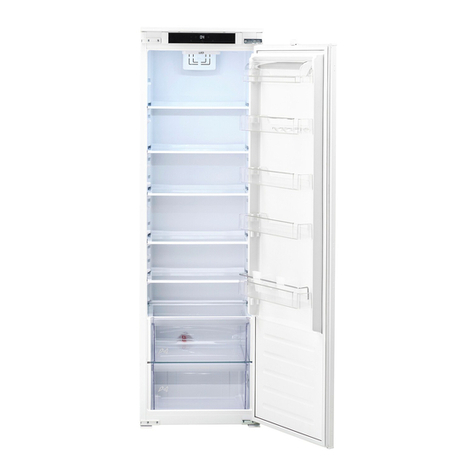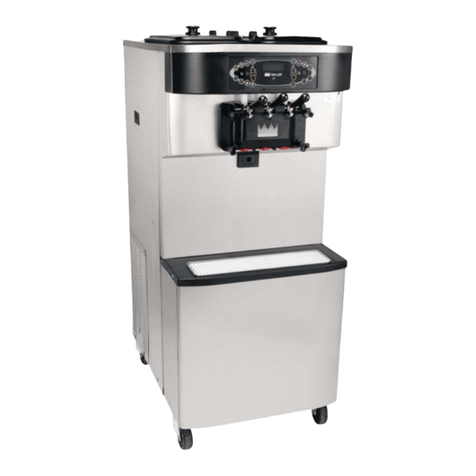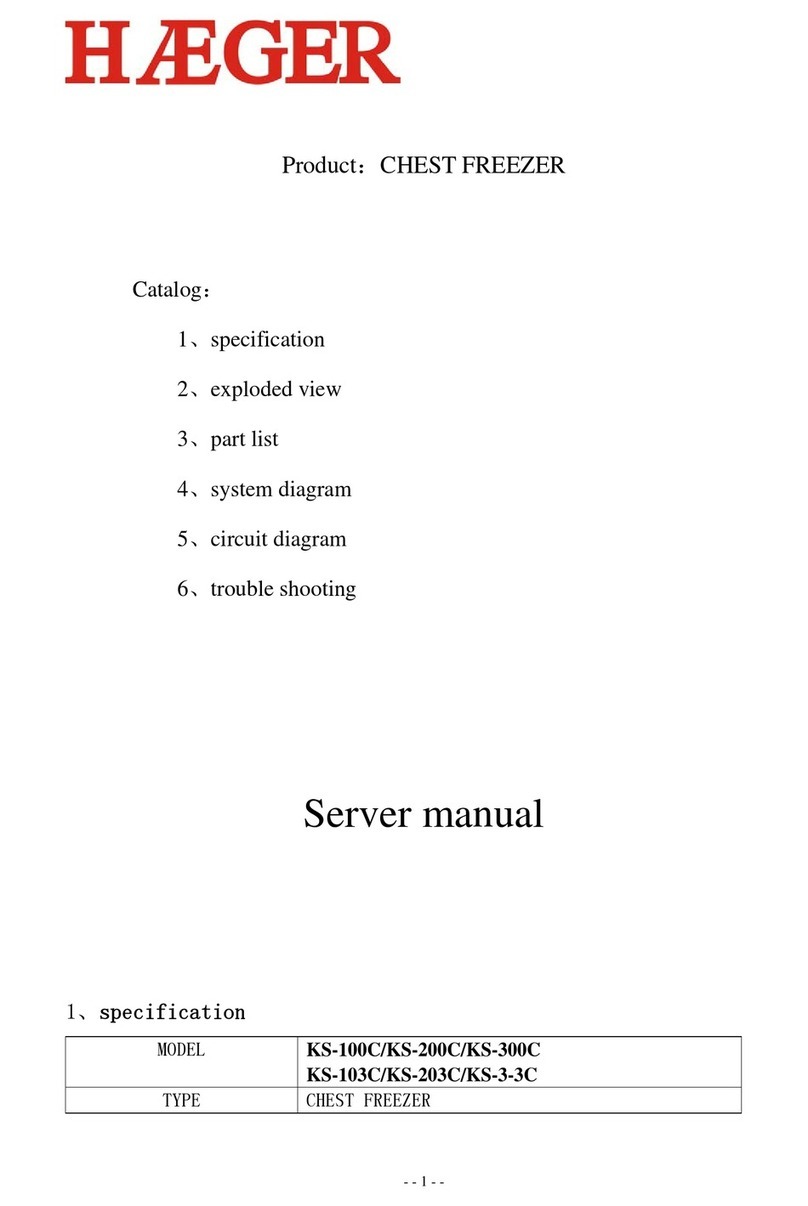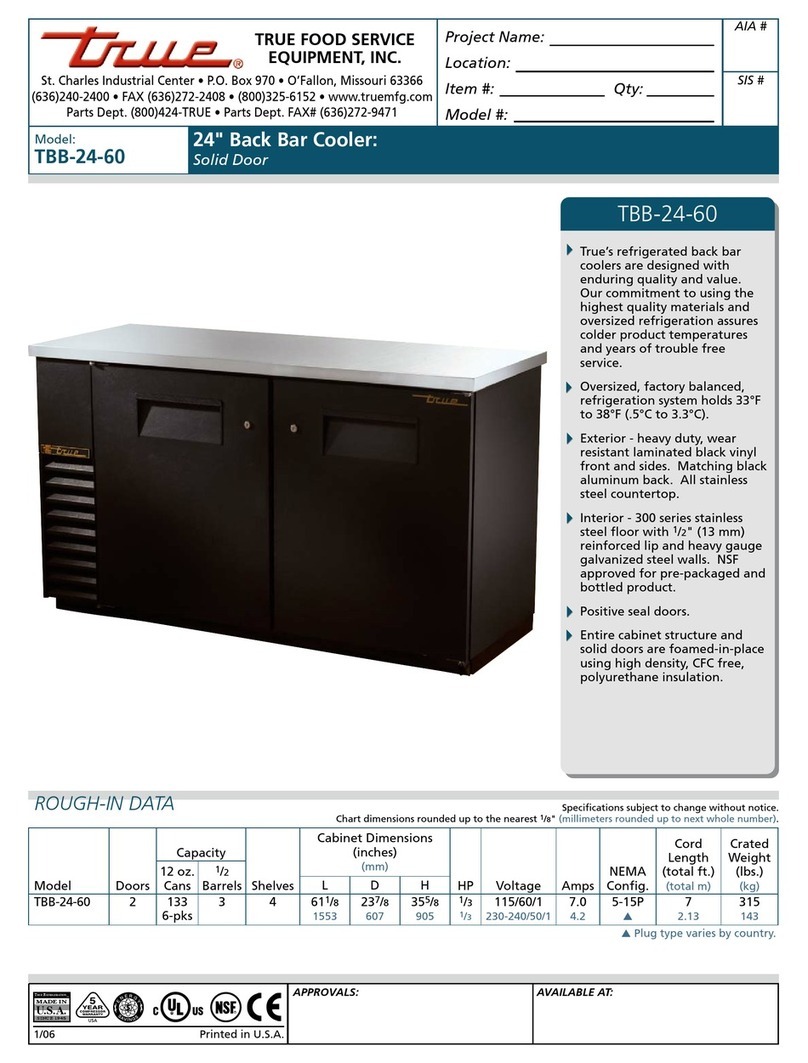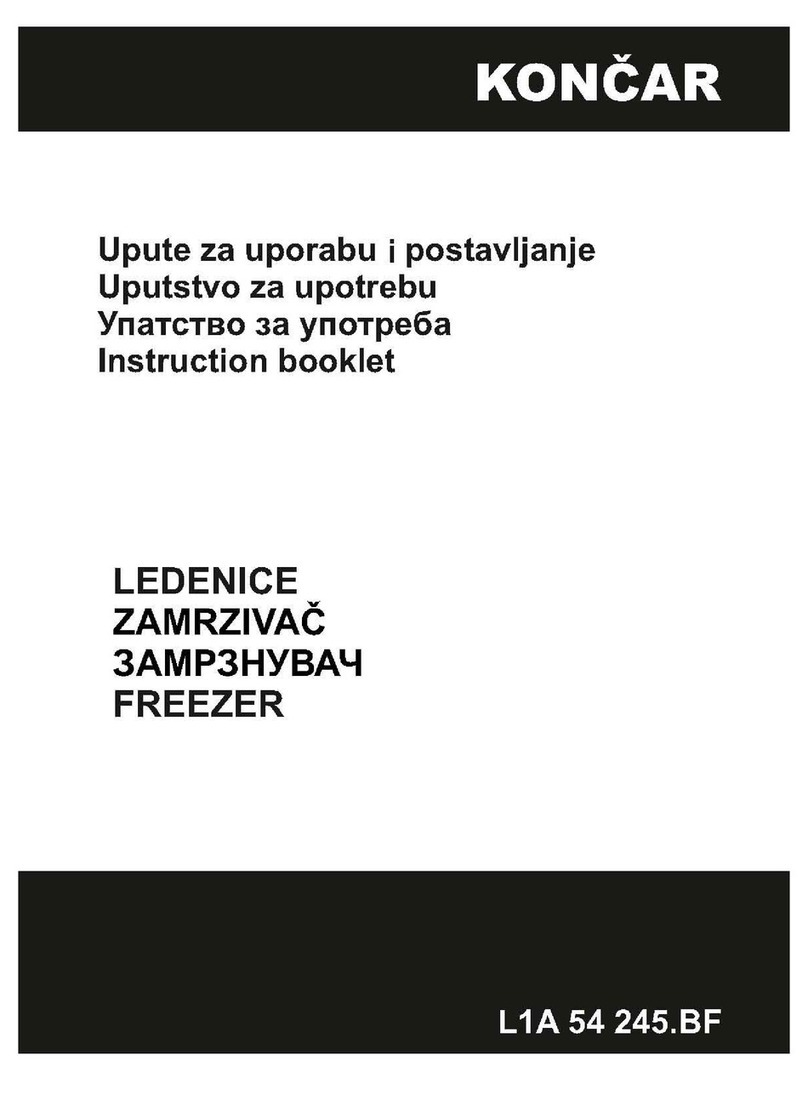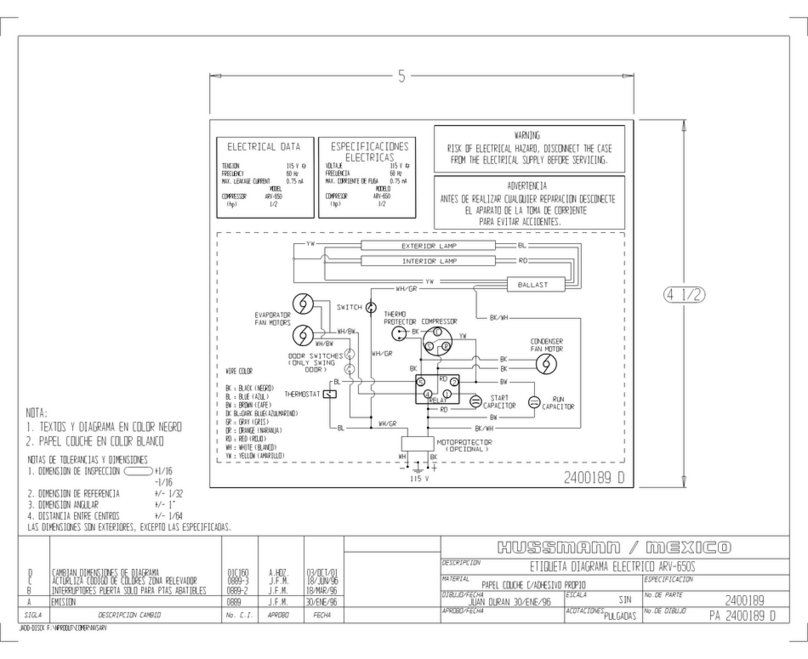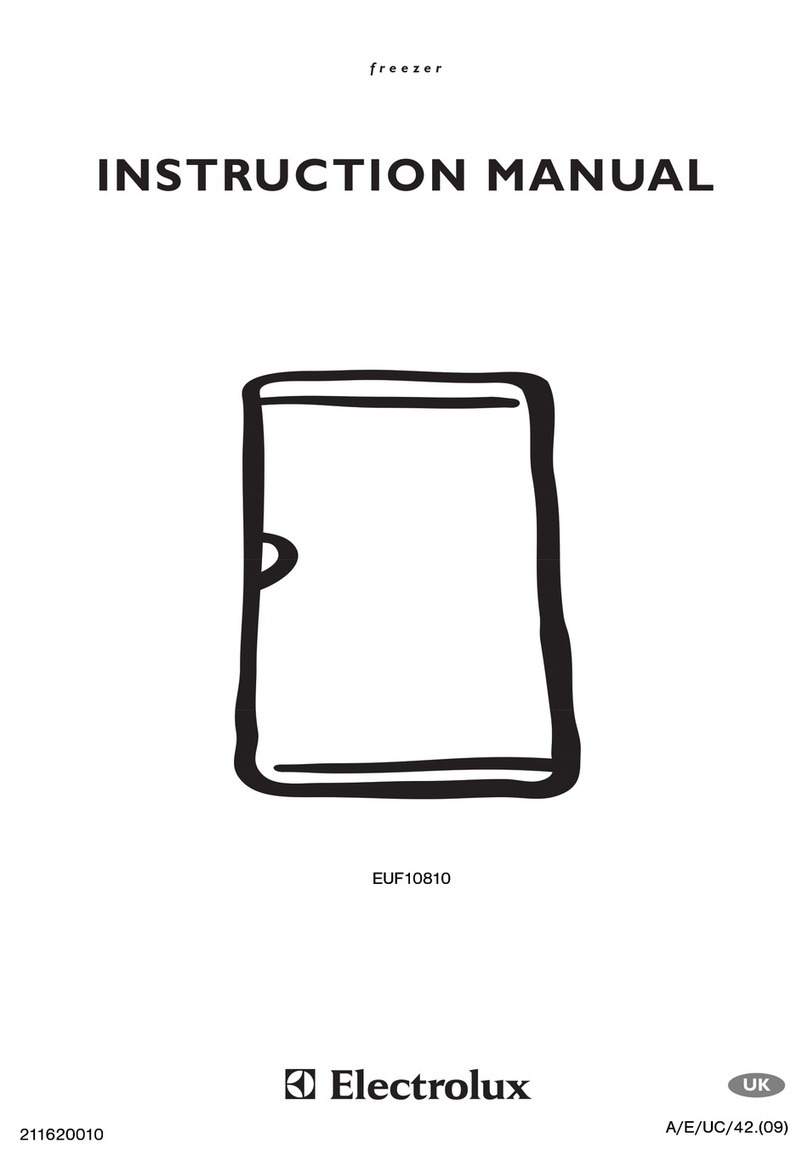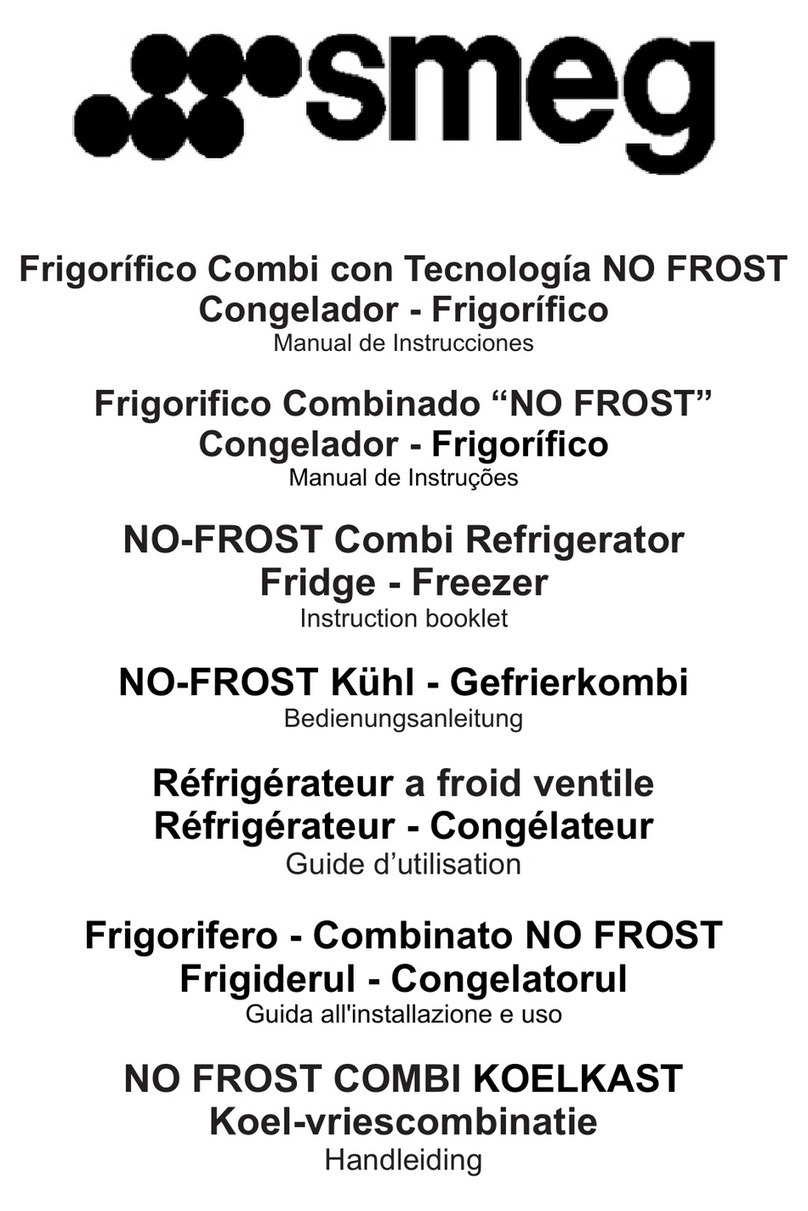BestMatic DDD-126288.3 User manual

DDD-126288.3
DDD-126288.4
DDD-126288.5
Fridge/freezer combi (EN)
Kühl/Gefrierkombination (DE)
Combiné réfrigérateur/congélateur (FR)
Koel-vriescombinatie (NL)
Lodówko-zamrażarka (PL)

- 1 -
Content –Inhalt –Teneur –Inhoud –Treść
Instruction manual –English......................................................................................- 2 -
Bedienungsanleitung –German...............................................................................- 15 -
Mode d‘emploi – French..........................................................................................- 29 -
Gebruiksaanwijzing –Dutch.....................................................................................- 44 -
Instrukcja obsługi – Polish........................................................................................- 57 -

- 2 -
Instruction manual –English
SAFETY INSTRUCTIONS
Before use make sure to read all of the below instructions in
order to avoid injury or damage, and to get the best results
from the appliance. Make sure to keep this manual in a safe
place. If you give or transfer this appliance to someone else
make sure to also include this manual.
In case of damage caused by user failing to follow the
instructions in this manual the warranty will be void. The
manufacturer/importer accepts no liability for damages
caused by failure to follow the manual, a negligent use or use
not in accordance with the requirements of this manual.
1. Read and save these instructions. Attention: pictures in
the IM are for reference only.
2. This appliance can be used by children aged from 8 years
and above and persons with reduced physical, sensory or
mental capabilities or lack of experience and knowledge if
they have been given supervision or instruction
concerning use of the appliance in a safe way and
understand the hazards involved. Children shall not play
with the appliance. Cleaning and user maintenance shall
not be made by children without supervision.
3. Children aged from 3 to 8 years are allowed to load and
unload refrigerating appliances.
4. If the supply cord is damaged, it must be replaced by the
manufacturer, its service agent or similarly qualified
persons in order to avoid a hazard.
5. WARNING: Keep ventilation openings, in the appliance
enclosure or in the built-in structure, clear of obstruction.
6. WARNING: Do not use mechanical devices or other means
to accelerate the defrosting process, other than those
recommended by the manufacturer.
7. WARNING: Do not damage the refrigerant circuit.
8. WARNING: Do not use electrical appliances inside the food
storage compartments of the appliance, unless they are of
the type recommended by the manufacturer.

- 3 -
9. Do not store explosive substances such as aerosol cans
with a flammable propellant in this appliance.
10. This appliance is intended to be used in household and
similar applications such as
-staff kitchen areas in shops, offices and other working
environments;
-farm houses and by clients in hotels, motels and other
residential type environments;
-bed and breakfast type environments;
-catering and similar non-retail applications.
11. WARNING: When positioning the appliance, ensure the
supply cord is not trapped or damaged.
12. WARNING: Do not locate multiple portable socket-outlets
or portable power supplies at the rear of the appliance.
13. To avoid contamination of food, please respect the
following instructions:
-Opening the door for long periods can cause a significant
increase of the temperature in the
compartments of the appliance.
-Clean regularly surfaces that can come in contact with
food and accessible drainage systems.
-Clean water tanks if they have not been used for 48h;
flush the water system connected to a water supply if
water has not been drawn for 5 days. (Only applicable to
water dispenser and water inlet system)
-Store raw meat and fish in suitable containers in the
refrigerator, so that it is not in contact with or drip onto
other food.
-Two-star frozen-food compartments are suitable for
storing pre-frozen food, storing or making ice cream and
making ice cubes.
-One-, two- and three-star compartments are not suitable
for the freezing of fresh food.
-If the refrigerating appliance is left empty for long
periods, switch off, defrost, clean, dry, and leave the
door open to prevent mould developing within the
appliance.

- 4 -
14. This refrigerating appliance is not intended to be used as a
built-in appliance.
15. Climate class:
-Extended temperate (SN): 'this refrigerating appliance is
intended to be used at ambient temperatures ranging
from 10°C to 32 °C';
-Temperate(N): 'this refrigerating appliance is intended to
be used at ambient temperatures ranging from 16 °C to
32 °C';
-Subtropical (ST): 'this refrigerating appliance is intended
to be used at ambient temperatures ranging from 16 °C
to 38 °C';
-Tropical(T): 'this refrigerating appliance is intended to be
used at ambient temperatures ranging from 16 °C to
43 °C'.
16. WARNING —The refrigerant and insulation blowing gas
are flammable. When disposing of the appliance, do so
only at an authorized waste disposal center. Do not expose
to flame.
WARNING! Risk of fire / flammable materials
Regarding the information pertaining to the installation,
handling, use, servicing, replacement of lamp (if applicable),
cleaning and disposal of the appliance, thanks to refer to the
below paragraph of the manual.
Electrical safety
We cannot be held responsible for any incident caused by
poor electrical installation. The power cord must not be
lengthened.
Make sure that the power plug is not crushed or damaged.
A crushed or damaged power plug may overheat and cause
a fire.
If the power plug socket is loose, do not insert the power
plug. There is a risk of electric shock or fire.

- 5 -
You must not operate the appliance without the interior
lighting lamp cover.
The appliance is only applied with power supply of single
phase alternating current of 220~240V/50Hz. The device
uses a wall socket earthed according to current
recommendations.
The socket must be readily accessible but out of reach of
children. If unsure, contact your installer.
Daily use
Do not store flammable gas or liquids in the appliance.
There is a risk of an explosion.
Do not operate any electrical appliances in the appliance
(e.g. electric ice cream makers, mixers etc.).
Never place bottles or jars containing liquids in the
refrigerator unless they are filled at 2/3 of their capacity,
freezing expands liquids and the container may explode.
When unplugging always pull the plug from the mains
socket. Do not pull on the cable.
Keep burning candles and other items with naked flames
away from the appliance so that do not set the appliance
on fire.
The appliance is intended for keeping food stuff.
The appliance is heavy. Care should be taken when moving
it.
If your machine has wheels, remember that they are only
used to facilitate small movements. Do not move it on
longer journeys.
Never use the base, drawers, doors etc. to stand on or as
supports.
To avoid items falling and causing injury or damage to the
appliance, do not overload the door racks or put too much
food in the crisper drawers.

- 6 -
Energy savings
To reduce the power consumption of your device:
Install it in a suitable location (see "Installing instructions").
Keep the doors open for as short time as possible.
Do not put hot food into your device.
Ensure the optimal functioning of your device by
periodically cleaning the condenser (see "Care and
maintenance").
Ensure the optimal functioning of your device by not
allowing too much frost accumulate in the refrigerator
(defrost it when the frost thickness exceeds 5-6 mm).
Periodically check the door seals and make sure they always
close effectively. If this is not the case, please contact your
after-sales service.
Service
Any electrical work required to do the servicing of the
appliance should be carried out by qualified electrician or
competent person.
This product must be serviced by an authorized Service
Center, and only genuine spare parts must be used.

- 7 -
DDD-126288.3 / DDD-126288.4 / DDD-126288.5 EN
PRODUCT DESCRIPTION
1. Glass shelf in freezer
2. Thermostat
3. Glass shelf in fridge
4. Crisper drawer
5. Freezer door
6. Fridge door
7. Pocket racks
8. Bottle rack
INSTALLATION INSTRUCTIONS
Location
When selecting a location for your appliance you should make sure the floor is flat and firm, and
the
room is
well ventilated. A distance between your device and the wall of between 5 and 10 cm must be respected. An
average ambient temperature must be observed.
Avoid locating your fridge near a heat source, eg, cooker, boiler or radiator. Also, avoid direct sunlight in out-
buildings or sun lounges. If you are placing your fridge in an out-building such as a garage or annex ensure that
the fridge is placed above the damp course, otherwise condensation will occur on the cabinet. Never place
the fridge in a wall recessed or into fitted cabinets or furniture when your fridge is working, the grille at the
back may become hot and the sides warm. It must therefore be installed so that the back of the fridge has
at least 9cm of free space and the sides have 2cm.
Do not drape the fridge with any covering.
Leveling the fridge
If the fridge is not level, the door and magnetic seal alignment will be affected and may cause your fridge to
work incorrectly. Once the fridge is placed in its final location, adjust the leveling feet at the front by turning
them.
Cleaning before use
Wipe the inside of the fridge with a weak solution of bicarbonate of soda. Then rinse with warm water using
a damp sponge or cloth. Wash the baskets and shelves in warm soapy water and dry completely before
replacing in the fridge.

- 8 -
Before plugging in
Check that you have a socket which is compatible with the plug supplied with the fridge.
Do not start the refrigerator immediately after vertical placement. Only start it after 2-6 hours standing to ensure
its proper operation.
Before filling your fridge
Before storing foods in your fridge, turn the fridge on and wait for 2-3 hours, to make sure it is working properly
and to allow the fridge to the correct temperature.
OPERATING YOUR APPLIANCE
Temperature Control
Your refrigerator has one control for regulating the temperature. The temperature control is located on the
right side of the fridge.
The range of the temperature control is from position "1" the warmest to "7" the coldest. Adjust the
temperature control to the setting that best suits your needs. The setting of “4” should be appropriate for
home or office refrigerator use.
Appliance thermostat has 7 settings. The appliance assures that temperature is maintained as long as it is in
operation and that it is used in normal conditions of use. The temperature inside the appliance can be
influenced by many factors: ambient temperature, sun exposure, number of doors opening and amount
of food
stored… The slight changes in temperature are perfectly normal.
•
Setting 1: Refrigerator compartment average temperature 10 to 14 °C / Freezer compartment average
temperature below -6 to -10°C
•
Setting 4: Refrigerator compartment average temperature 4 to 8 °C / Freezer compartment average
temperature -13 to -17°C
•
Setting 7: Refrigerator compartment average temperature -2 to 2 °C / Freezer compartment average
temperature -20 to -24°C
NOTE:
•
If the unit is unplugged, lost power, or turned off; you must wait 5 minutes before restarting the unit. If you
attempt to restart before this time, the refrigerator will not start.
•
If you choose to change the thermostat setting, adjust thermostat control by one numerical increment at a
time. Allow several hours for temperature to stabilize between adjustments.
•
The temperature will impact the storage time of food. Set the temperature as necessary. Warmer will
accelerate food spoilage and colder will freeze food bad. Thus, food to be wasted.
Do not leave the door open for too long so that the indoor temperature does not rise too much.
FOOD CONSERVATION
Food preservation and storage
Under recommended setting, the best storage time of fridge is no more than 3 days. The best storage time
may reduce other settings.
Refrigerator compartments
Type of food
Door or racks of fridge compartment
Foods with natural preservatives, such as jams,
juices, drinks, condiments.
Do not store perishable foods.
Crisper drawer (salad drawer)
Fruits, herbs and vegetables should be placed
separately in the crisper bin.
Do not store bananas, onions, potatoes, garlic in
the refrigerator.
Fridge shelf - middle
Dairy products, eggs
Fridge shelf - top
Foods that do not need cooing, such as ready-to-
eat foods, deli meats, leftovers.

- 9 -
PREPARING FOOD FOR THE REFRIGERATOR
Carefully wrap fresh foods: they will then keep their flavor, color, humidity content and freshness. You also
avoid the taste of some foods contaminating the taste of others. Only vegetables, fruit and salad vegetables
can be stored in the crisper drawer without being packed. Let hot dishes and drinks cool down outside the
appliance. Remove the cardboard packs from around yoghurt pots. Check the consume-by dates on the
products you have bought. You should not exceed these.
ARRANGING FOOD IN YOUR REFRIGERATOR
The temperature inside your refrigerator is not uniform. Some areas are colder than others and you must
store your food in the appropriate areas according to their type to ensure that they can be kept safely.
Leave a space between the food items to allow the air to circulate freely and avoid different product
contaminating each other.
Do not put packages and food in contact with the wall at the back of the appliance, this is a particularly cold
and damp area of the appliance and water droplets and frost condense there as part of your refrigerator's
normal operation.
FROZEN AND DEEP- FROZEN FOOD
Your domestic appliance enables you to freeze food, it lowers its core temperature rapidly and you can
therefore keep it longer.
Deep-freezing is an industrial process that is quicker and more intense than domestic freezing. The products
you purchase from the shops are deep-frozen.
PREPARING FOOD FOR FREEZING
Freezing does not sterilize. It is therefore important to observe some simple hygiene rules when preparing
your food for freezing: wash your hands before you touch the food and clean the kitchen tools you have just
used before using them again.
Only freeze fresh, good quality food. Refer to the table "Food Freezing Guide" to know which products you
can freeze and how long you can keep them.
Blanch fruit and vegetables before freezing them to preserve their color, smell, taste and vitamins: plunge
them in boiling water for few moments.
Divide the food you wish to freeze into small individual portions corresponding to one meal each. Small
portions freeze quicker at their core.
Pack the food hermetically so that they do not lose their flavor or dry out. Use plastic bags, polyethylene film,
aluminum foil or special freezer containers for this. If you are using plastic bags, compress them to eliminate
the air before sealing them hermetically.
Note on each package:
-The freezing date
-The consume-by date
-The type of food contained
-The number of portions contained
If you are purchasing deep-frozen food, pick it up last when you are shopping.
Check that:
- The packaging isn't damaged.
- They are not covered in a layer of frost (which means that they have partially defrosted).
Pack them in an isotherm bag or in newspaper. Transport them quickly and store them immediately. Comply
with the maximum storage dates shown on the pack. Your appliance has a 4-star freezer compartment, this
enables you to keep deep-frozen food in an optimal manner.
ARRANGING FOOD IN YOUR FREEZER
Do not put fresh food next to food that has already been frozen to avoid causing the frozen food to warm up.

- 10 -
DEFROSTING FOOD
You can defrost food in five different ways:
- By putting them in your appliance's refrigerator section for several hours
- By leaving them to defrost gently at ambient temperature
- In a conventional oven at a very low temperature (40/50°C)
- In a microwave oven
- By cooking them immediately
Defrosting them in the refrigerator is the slowest but safest method.
Never refreeze food once it has defrosted, even partially, without cooking it first.
We would advise you not to place any items you have just taken out of the freezer straight into your mouth
(ice cream, ice cubes, etc.), they will be at a very low temperature and you risk frostbite.
Avoid touching frozen or deep-frozen food with wet hands; you may stick to the food. We recommend that
you only defrost food for immediate use.
Food Freezing Guide
Target storage temp. (°C )
Appropriate food
≤-18
Seafood (fish, shrimp, shellfish), freshwater aquatic products and meat
products (recommended for 3 months, the longer the storage time, the
worse the taste and nutrition), suitable for frozen fresh food.
CARE AND MAINTENANCE
Defrosting
The defrost of fridge part is automatic and for freezer part is manual.
•
Set the thermostat to "0" for defrosting.
•
Unplug your appliance from the mains power.
•
Remove all contents from the appliance.
•
Leave the fridge door open to allow melting of the ice.
•
Remove large pieces of ice if necessary with dishcloth or something that will not damage the walls.
•
Do not use hot water or other electric heaters to melt the accumulated ice.
•
After defrosting, remove the accumulated ice / water and dry the appliance with a soft cloth.
•
Restart the unit according to the start instructions. Never use a knife or other sharp instrument to scrape
ice inside.
Cleaning inside the fridge
Before maintenance, switch off the appliance and disconnect the mains plug from the mains socket. After
defrosting you should clean the fridge internally with a weak solution of bicarbonate of soda. Then rinse with
warm water using a damp sponge or cloth and wipe dry. Wash the baskets in warm soapy water and ensure
they are completely dry before replacing in the fridge. Condensation will form on the back wall of the fridge;
however, it will normally run down the back wall and into the drain hole behind the salad bin.
Cleaning outside the fridge
Before maintenance, switch off the appliance and disconnect the mains plug from the mains socket. Use
standard non-abrasive detergent diluted in warm water to clean the fridge exterior.
Do not use harsh cleaners, scouring pads or solvents to clean any part of the fridge.
Energy saving tips
1. Let hot foods cool to room temperature before placing in the refrigerator. Overloading the refrigerator
forces the compressor to run longer. Foods that freeze too slowly may lose quality, or spoil.
2. Be sure to wrap foods properly, and wipe containers dry before placing them in the refrigerator. This cuts
down on frost build-up inside the refrigerator.
3. Refrigerator storage bin should not be lined with aluminum foil, wax paper, or paper toweling. Liners
interfere with cold air circulation, making the refrigerator less efficient.
4. Organize and label food to reduce door openings and extended searches. Remove as many items as needed
at one time, and close the door as soon as possible.

- 11 -
Switching off your appliance
If the appliance needs to be switched off for an extended period, the following steps should be taken to prevent
mould on the appliance.
1. Remove all food;
2. Switch off the appliance by setting the thermostat to position “0”;
3. Remove the power plug from the mains socket;
4. Clean and dry the interior thoroughly;
5. Ensure that all the doors are wedged open slightly to allow air to circulate.
Replacing the light bulb
If the internal light does not work anymore, disconnect then reconnect at once the device.
If the light does not still work, verify if the light bulb is correctly screwed. If in spite of these tests, there is no
light, it is necessary to change the light bulb. Use a 220-240V~, MAX 10W light bulb.
1. Disconnect the appliance;
2. Open the light cover;
3. Undo the defective light bulb anticlockwise.
4. Screw the new light bulb clockwise.
DOOR REVERSE
Users can change the direction of opening according to one's own needs. The concrete operating sequence is as
follows: (The pictures below are for the guideline to reverse the door. The appearance of the appliance may be
different from the product you purchased.)
1
Remove the top hinge cover.
2
Lift the door upwards to disengage it from the
middle hinge, put the door to one side and lay it
down gently on a padded surface.
Replaceable (LED only) light source by a
professional
This product contains a light source of
energy efficiency class G.

- 12 -
3
Using a screwdriver, dismantle from the middle
hinge, lift the door upwards to disengage it
from the lower hinge. Put the door to one
side and lay it down gently on a padded surface.
4
Take out the hinge pin out, rotate the hinge 180
degrees, reverse and reinstall it to the opposite
side. Swap over the position of the lower hinge
and the adjustable leg to the other side of the
cabinet.
5
Remove the hinge pin that is in the bottom of the
fridge and freezer door. At the other side of
fridge and freezer door, insert the replacement
hinge pin that is supplied with the appliance
inside the parts bag.
6
Place the freezer door on the lower hinge,
making sure that the hinge pin is inserted in the
hole at the bottom of the freezer door, put the
middle hinge back on the cabinet, making sure
that it is on the opposite side from its original
position.
7
Place the fridge door on the middle hinge,
making sure that the hinge pin is inserted in the
hole at the bottom of the fridge door. Place the
top hinge on the fridge door, fixing the screw and
cover.

- 13 -
8
Take out the top hinge from top refrigerator
door, rotate the top hinge 180 degrees, take out
the hinge pin out, reverse and reinstall it to the
opposite side.
9
Take the left top hinge cover parts from the bag
and install it to the left side, tighten all the
screws.
TROUBLESHOOTING
Symptom
Cause
Solution
The appliance does not
work.
There is no power supply.
Verify that the appliance is connected to the
plug.
The fuse doesn’t work.
Replace the fuse.
The appliance makes a
lot of noise.
The appliance is too close to the wall,
or is not stable, or the accessories
inside the refrigerator are placed in
wrong position.
Stabilize the base of the refrigerator by
adjusting the position of feet, take away the
device off the wall, place correctly the
accessories inside the refrigerator.
The appliance doesn’t
cool enough.
The door is too often opened or was
left opened for a long time.
Close the door and do not open it too much
frequently.
The refrigerator is too close to the
wall.
Take away the device off the wall for the
ventilation.
The refrigerator is too full.
Remove food of the device.
The temperature is badly adjusted.
Turn the knob of regulation of temperature
on “3” or more.
There are smells in the
appliance.
Food becomes obsolete inside the
refrigerator.
Throw away the obsolete food and wrap
the other.
The inside of the device needs to
be cleaned.
Clean the inside of the refrigerator.
The door is difficult to
open
It is normal for the door to offer
some resistance to being opened,
particularly when you have just
shut it: a slight under pressure
forms in your appliance to ensure
the door seals perfectly.
All you have to do is wait a few seconds
before re-opening.
TECHNICAL SPECIFICATIONS
Rated voltage:
220-240V~
Rated current:
2.0A
Rated frequency:
50Hz
Lamp power:
MAX 10W
Climate class:
N/ST
Refrigerant:
R600a(66g)
Protection against electrical shock:
I
Insulation blowing gas:
CYCLOPENTANE

- 14 -
Climate class:
-Extended temperate (SN): 'this refrigerating appliance is intended to be used at ambient temperatures
ranging from 10°C to 32 °C';
-Temperate(N): 'this refrigerating appliance is intended to be used at ambient temperatures ranging from
16 °C to 32 °C';
-Subtropical (ST): 'this refrigerating appliance is intended to be used at ambient temperatures ranging from
16 °C to 38 °C';
-Tropical(T): 'this refrigerating appliance is intended to be used at ambient temperatures ranging from 16 °C
to 43 °C';
Note: More data information, please scan the QR code on the energy label.
GUARANTEE AND CUSTOMER SERVICE
Before delivery our devices are subjected to rigorous quality control. If, despite all care, damage has occurred
during production or transportation, please return the device to your dealer. In addition to statutory legal rights,
the purchaser has an option to claim under the terms of the following guarantee:
For the purchased device we provide 2 years guarantee, commencing from the day of sale. If you have a
defective product, you can directly go back to the point of purchase.
Defects which arise due to improper handling of the device and malfunctions due to interventions and repairs
by third parties or the fitting of non-original parts are not covered by this guarantee. Always keep your receipt,
without the receipt you can’t claim any form of warranty. Damage caused by not following the instruction
manual, will lead to a void of warranty, if this results in consequential damages then we will not be liable. Neither
can we hold responsible for material damage or personal injury caused by improper use or if the instruction
manual are not properly executed. Damage to accessories does not mean free replacement of the whole
appliance. In such case please contact our service department. Broken glass or breakage of plastic parts is always
subject to a charge. Defects to consumables or parts subjected to wearing, as well as cleaning, maintenance or
the replacement of said parts are not covered by the warranty and are to be paid.
The guarantee period of the spare parts is 2 years. If you need replacement, please contact our customer service.
ENVIRONMENT FRIENDLY DISPOSAL
Recycling –European Directive 2012/19/EU
This marking indicates that this product should not be disposed with other household wastes. To
prevent possible harm to the environment or human health from uncontrolled waste disposal,
recycle it responsibly to promote the sustainable reuse of material resources. To return your used
device, please use the return and collection systems or contact the retailer where the product was
purchased. They can take this product for environmental safe recycling.
For professional repair and ordering spare parts, please contact our customer service.
Manufactured by: Emerio Deutschland GmbH
Lerchenweg 3, 40789 Monheim am Rhein, Deutschland
Service Hot Line: +49 3222 1097 615

- 15 -
Bedienungsanleitung –German
SICHERHEITSINFORMATIONEN
Lesen Sie vor dem Gebrauch unbedingt die nachfolgenden
Anleitungen, um Verletzungen oder Beschädigungen zu
vermeiden und das beste Ergebnis mit dem Gerät zu erzielen.
Bewahren Sie diese Bedienungsanleitung an einem sicheren
Ort auf. Wenn Sie dieses Gerät an eine andere Person
weitergeben, stellen Sie sicher, dass Sie auch diese
Bedienungsanleitung aushändigen.
Im Falle von Beschädigungen, die durch die Missachtung der
Anleitungen in dieser Bedienungsanleitung verursacht
wurden, wird die Garantie ungültig. Der Hersteller/Importeur
haftet nicht für Schäden, die durch Missachtung der
Bedienungsanleitung, fahrlässigen Gebrauch oder Benutzung,
die nicht in Übereinstimmung mit den Anforderungen dieser
Bedienungsanleitung erfolgt, verursacht wurden.
1. Lesen und bewahren Sie diese Anleitungen auf. Achtung:
Die Bilder in der Bedienungsanleitung dienen nur zur
Veranschaulichung.
2. Dieses Gerät kann von Kindern ab 8 Jahren und von
Personen mit eingeschränkten physischen, sensorischen
oder geistigen Fähigkeiten oder ohne Erfahrung und/oder
Wissen benutzt werden, wenn diese durch eine für ihre
Sicherheit zuständige Person beaufsichtigt werden oder
von ihr Anweisungen erhielten, wie das Gerät sicher zu
benutzen ist und sie auf die Risiken aufmerksam gemacht
wurden. Kinder dürfen nicht mit dem Gerät spielen. Kinder
sollten dieses Gerät nicht unbeaufsichtigt reinigen oder
warten.
3. Kinder im Alter zwischen 3 und 8 Jahren dürfen Kühlgeräte
befüllen und leeren.
4. Wenn die Netzanschlussleitung dieses Gerätes beschädigt
wird, muss sie durch den Hersteller oder seinen
Kundendienst oder eine ähnlich qualifizierte Person ersetzt
werden, um Gefährdungen zu vermeiden.

- 16 -
5. WARNUNG: Halten Sie die Lüftungsöffnungen im Gehäuse
oder direkt im Gerät frei von Hindernissen.
7. WARNUNG: Beschädigen Sie den Kältemittelkreislauf nicht.
8. WARNUNG: Verwenden Sie keine elektrischen Geräte in
den Lebensmittelfächern des Geräts, es sei denn, sie
entsprechen dem Typ, der vom Hersteller empfohlen wird.
10. Dieses Gerät ist dazu bestimmt, im Haushalt und ähnlichen
Anwendungsbereichen benutzt zu werden, wie z.B.:
-in Personalküchen von Ladengeschäften, Büros und
anderen Arbeitsumgebungen,
-auf Bauernhöfen, von Gästen in Hotels, Motels und
anderen Wohnumgebungen,
-Pensionen und ähnlichen Unterkünften,
-im Catering und ähnlichen Nicht-Einzelhandelsbereichen.
11. WARNUNG: Stellen Sie das Gerät so auf, dass das
Versorgungskabel nicht eingeklemmt oder beschädigt wird.
12. WARNUNG: Stellen Sie keine Mehrfachsteckdosen oder
tragbare Stromquellen an der Rückseite des Geräts auf.
13. Um eine Kontamination von Lebensmitteln zu vermeiden,
beachten Sie bitte folgende Hinweise:
-Ein längeres Ö ffnen des Deckels kann zu einer deutlichen
Erhöhung der Temperatur im Gerät führen.
-Reinigen Sie regelmäßig die Oberflächen, die mit
Lebensmitteln und den zugänglichen Abläufen in
Berührung kommen können.
-Reinigen Sie die Wasserbehälter, wenn diese 48 Stunden
lang nicht benutzt wurden. Spülen Sie den
Wasserkreislauf, wenn 5 Tage lang kein Wasser
verbraucht wurde.
(
Gilt nur für Wasserspender und
Wasserzulauf)
6. WARNUNG: Verwenden Sie keine anderen als die vom
Hersteller empfohlenen mechanischen Geräte oder andere
Mittel, um den Abtauvorgang zu beschleunigen.
9. Lagern Sie keine explosiven Substanzen wie Aerosoldosen
mit einem brennbaren Treibmittel in diesem Gerät.

- 17 -
-Bewahren Sie Fleisch und Fisch in geeigneten
Behältnissen im Kühlschrank auf, damit sie keinen
Kontakt mit anderen Lebensmitteln bekommen oder auf
sie tropfen können.
-Zum Einfrieren frischer Lebensmittel sind Tiefkühlfächer
mit einem, zwei oder drei Sternen nicht geeignet.
-Wenn das Kühlgerät längere Zeit leer bleibt, schalten Sie
es aus, tauen Sie es ab, reinigen und trocknen sie es.
Lassen Sie die Tür geöffnet, damit sich im Geräteinneren
kein Schimmel bildet.
14. Dieses Kühlgerät ist nicht als Einbaugerät vorgesehen.
15. Klimaklasse:
-SN (Subnormal): Das Kühlgerät eignet sich für
Umgebungstemperaturen von 10 bis 32 °C.
-N (Normal): Das Kühlgerät eignet sich für
Umgebungstemperaturen von 16 bis 32 °C.
-ST (Subtropisch): Das Kühlgerät eignet sich für
Umgebungstemperaturen von 16 bis 38 °C.
-T (Tropisch): Das Kühlgerät eignet sich für
Umgebungstemperaturen von 16 bis 43 °C.
16. WARNUNG - Das Kältemittel und das Isolationstreibgas
sind brennbar. Entsorgen Sie das Gerät nur bei einer
autorisierten Sammelstelle zur Entsorgung dieser Art von
Produkten. Schützen Sie das Gerät vor Feuer.
WARNUNG! Brandgefahr / zündfähige Materialien
Um Informationen zu Installation, Benutzung, Handhabung,
Wartung, Austausch der Lampe (sofern zutreffend),
Reinigung und Entsorgung zu erhalten, lesen Sie bitte den
nachfolgenden Abschnitt in der Bedienungsanleitung.
-Tiefkühlfächer mit 2 Sternen eignen sich für die
Aufbewahrung tiefgekühlter Lebensmittel, zum
Aufbewahren oder Herstellen von Speiseeis und
Eiswürfeln.

- 18 -
Elektrische Sicherheit
Wir haften nicht für Vorfälle, die durch eine unsachgemäße
Elektroinstallation verursacht werden. Das Netzkabel darf
nicht verlängert werden.
Stellen Sie sicher, dass der Netzstecker nicht gequetscht
oder beschädigt wird. Ein gequetschter oder beschädigter
Netzstecker kann sich überhitzen und einen Brand
verursachen.
Stecken Sie den Netzstecker nicht in eine Steckdose, die
lose ist. Andernfalls besteht die Gefahr eines Stromschlags
oder Feuers.
Das Gerät darf nicht ohne die Abdeckung der Glühlampe im
Geräteinneren benutzt werden.
Das Gerät ist nur für den Betrieb mit 220~240V/50Hz
Einphasenwechselstrom ausgelegt. Das Gerät muss an eine
vorschriftsmäßig geerdete Wandsteckdose angeschlossen
werden.
Die Steckdose muss schnell zugänglich sein, sich jedoch
außer Reichweite von Kindern befinden. Falls Sie sich nicht
sicher sind, wenden Sie sich an Ihren Installateur.
Täglicher Gebrauch
Lagern Sie keine brennbaren Gase oder Flüssigkeiten im
Gerät. Es besteht Explosionsgefahr.
Betreiben Sie keine elektrischen Geräte in diesem Gerät
(z. B. elektrische Eismaschinen, Mixer usw.)
Stellen Sie niemals Flaschen oder Gläser mit Flüssigkeiten
in den Kühlschrank; es sei denn, sie sind nur bis zu 2/3 ihres
Fassungsvermögens gefüllt. Durch das Gefrieren dehnen
sich Flüssigkeiten aus und der Behälter könnte explodieren.
Fassen Sie immer am Stecker an, um das Gerät von der
Netzsteckdose zu trennen. Ziehen Sie nicht am Kabel.
Halten Sie brennende Kerzen und andere Gegenstände mit
offenen Flammen vom Gerät fern, damit es nicht Feuer
fängt.
Dieses Gerät ist für die Lagerung von Lebensmitteln
vorgesehen.

- 19 -
Das Gerät ist schwer. Beim Umstellen des Geräts ist
deshalb Vorsicht geboten.
Denken Sie daran: Sollte Ihr Gerät mit Rollen ausgestattet
sein, dienen diese nur dazu, kleine Bewegungen zu
erleichtern. Bewegen Sie das Gerät nicht über längere
Strecken.
Stellen oder stützen Sie sich niemals auf die Basis,
Schubladen, Türen usw.
Um zu verhindern, dass Lebensmittel herausfallen und
Verletzungen oder Beschädigungen am Gerät verursachen,
überladen Sie die Türregale und Gemüsefächer nicht.
Energie sparen
Um den Stromverbrauch Ihres Gerätes zu reduzieren:
Stellen Sie es an einem geeigneten Ort auf (siehe
„Installationsanweisungen“).
Ö ffnen Sie die Türen so kurz wie möglich.
Stellen Sie keine warmen Speisen in Ihr Gerät.
Stellen Sie die optimale Funktionsfähigkeit Ihres Geräts
sicher, indem Sie den Kondensator regelmäßig reinigen
(siehe „Pflege und Wartung“).
Stellen Sie die optimale Funktionsfähigkeit Ihres Geräts
sicher, indem Sie dafür sorgen, dass sich nicht übermäßig
viel Reif im Kühlschrank bildet. (Gerät abtauen, wenn die
Reifschicht dicker als 5 bis 6 mm ist.)
Prüfen Sie die Türdichtungen regelmäßig und stellen Sie
sicher, dass sich die Türen immer hermetisch schließen
lassen. Sollte dies nicht der Fall sein, wenden Sie sich bitte
an Ihren Kundendienst.
Reparatur
Sollten elektrische Arbeiten für die Reparatur des Geräts
erforderlich sein, dürfen diese nur von qualifizierten
Elektrikern oder sachkundigen Personen ausgeführt
werden.
Dieses Produkt darf nur von einer autorisierten Werkstatt
und nur unter Verwendung von Original-Ersatzteilen
repariert werden.
This manual suits for next models
2
Table of contents
Languages:
Other BestMatic Freezer manuals

